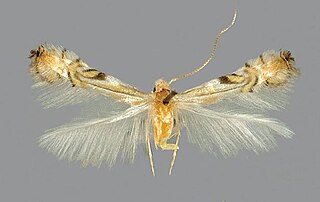
Phyllocnistis is a genus of moths in the family Gracillariidae.
Phyllocnistis exaeta is a moth of the family Gracillariidae, known from Assam, India. It was named by E. Meyrick in 1926.
Phyllocnistis habrochroa is a moth of the family Gracillariidae, known from Karnataka, India. The hostplant for the species is Abatia stellata. It was named by E. Meyrick in 1915.
Phyllocnistis hyperbolacma is a moth of the family Gracillariidae, known from Honshū, Japan. It was named by E. Meyrick in 1931.
Phyllocnistis micrographa is a moth of the family Gracillariidae, known from Karnataka, India. It was named by E. Meyrick in 1916.
Phyllocnistis oxyopa is a moth of the family Gracillariidae, known from Maharashtra, India. It was named by E. Meyrick in 1918.
Phyllocnistis signata is a moth of the family Gracillariidae, known from Tamil Nadu, India. It was described by E. Meyrick in 1915.
Acrocercops amethystopa is a moth of the family Gracillariidae, known from Karnataka, India. It was described by E. Meyrick in 1916.
Acrocercops clepsinoma is a moth of the family Gracillariidae, known from Tamil Nadu, India. It was described by Edward Meyrick in 1916.
Acrocercops crystallopa is a moth of the family Gracillariidae, known from Karnataka, India. It was described by Edward Meyrick in 1916. The hostplants for the species include Memecylon amplexicaule and Memecylon edule.
Acrocercops diatonica is a moth of the family Gracillariidae, known from Karnataka, India, as well as West Malaysia, Papua New Guinea, and Thailand. It was described by Edward Meyrick in 1916. The hostplant for the species is Theobroma cacao and Mangifera species.
Acrocercops extenuata is a moth of the family Gracillariidae, known from Karnataka, India. It was described by Edward Meyrick in 1916.
Acrocercops hapalarga is a moth of the family Gracillariidae, known from Karnataka, India. It was described by Edward Meyrick in 1916.
Acrocercops hemiglypta is a moth of the family Gracillariidae, known from Karnataka, India. It was described by Edward Meyrick in 1916.
Acrocercops lysibathra is a moth of the family Gracillariidae, known from Bihar, India. It was described by Edward Meyrick in 1916. The hostplants for the species include Cordia latifolia and Cordia myxa.
Acrocercops macroclina is a moth of the family Gracillariidae, known from Karnataka, India, as well as Fiji and Malaysia. It was described by Edward Meyrick in 1915. The hostplants for the species include Caesalpinia bonduc, Derris elliptica, and Moullava spicata.
Acrocercops prompta is a moth of the family Gracillariidae, known from Tamil Nadu, India. It was described by Edward Meyrick in 1916.
Acrocercops pharopeda is a moth of the family Gracillariidae, known from Karnataka, India. It was described by Edward Meyrick in 1916.
Acrocercops phaeospora is a moth of the family Gracillariidae, known from Karnataka, India. It was described by Edward Meyrick in 1916. The hostplants for the species include Vigna mungo, Vigna unguiculata, Cleistocalyx operculatus, Eugenia cumini, Eugenia jambolana, Syzygium littorale, Madhuca latifolia, and Theobroma cacao.

